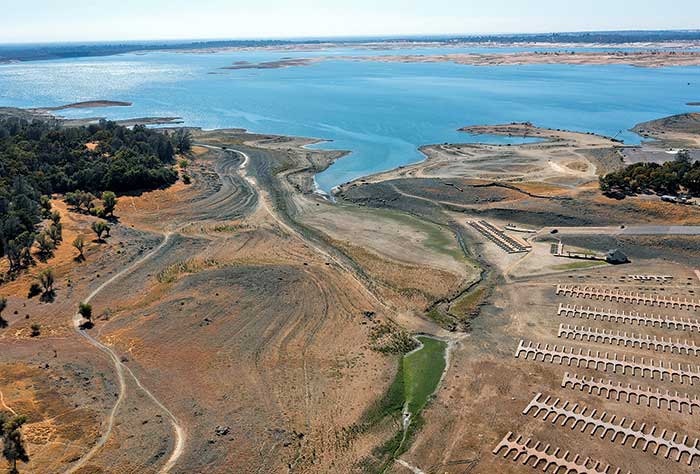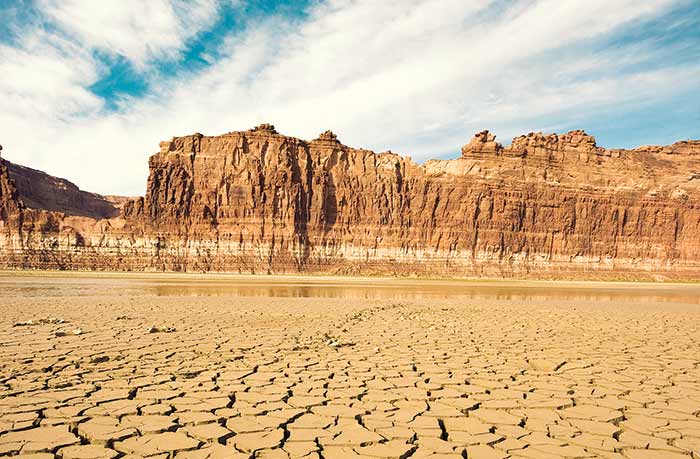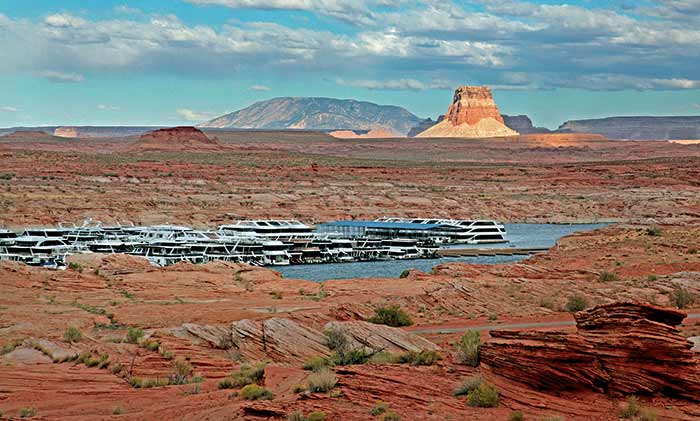Advertisement
Here's how some of Western America's most iconic lakes are shrinking, which is changing the way we boat.

A marina on California's Folsom Lake has been left dry by the recent droughts in the Western U.S. (Photo: Getty Images/Matt Gush)
A white mineral "bathtub ring" bands the rocky perimeter of Lake Mead, a ghostly reminder of where the high-water mark once stood. As of February, the largest reservoir in the United States, located on the border of Arizona and Nevada, was at 1,067 feet (just 35% of its capacity). The water level hasn't been this low since the 1930s when the lake was being filled.
Lake Mead was just one of several iconic U.S. lakes to see record low water levels in 2021.
As of last October, nearly half (47%) of the landmass of the continental U.S. — which is approximately 90% of the West — was experiencing drought. The extreme conditions stretched from the West, up into parts of the High Plains and Midwest, with swaths of territory experiencing "exceptional drought," the highest level recognized by the U.S. Drought Monitor.
The impact is particularly startling in the hard-hit Southwest states of Arizona, California, Colorado, Nevada, New Mexico, and Utah, which from January 2020 through August 2021, received the lowest total precipitation and had the third-highest average daily temperatures since 1895.
Dry forests burned by the millions of acres. One of California's largest hydroelectric plants was forced offline for the first time since it opened in 1967. Production of wheat, barley, and bean crops dropped approximately 50% in recent years. Deer, bears, raccoons, and other wildlife struggled to find food and water, with some state agencies resorting to air-dropping water by helicopter to keep important species alive. All told, the expected economic losses may be in the tens of billions of dollars, according to NOAA's Climate Program Office.
The situation is so dire that five of the six Southwestern states are in a drought state of emergency. Even the federal government stepped in, declaring the first-ever water shortage in the Colorado River Basin.
What's The U.S. Drought Monitor?
The U.S. Drought Monitor is a map released every Thursday, showing parts of the U.S. that are in drought. The weekly tracker has been a team effort since its inception in 1999, produced jointly by the National Drought Mitigation Center (NDMC) at the University of Nebraska-Lincoln, the National Oceanic and Atmospheric Administration (NOAA), and the U.S. Department of Agriculture (USDA). NDMC hosts the website of the drought monitor and the associated data, and provides the map and data to NOAA, USDA, and other agencies.
High And Dry
Lake boaters experienced the drought from a unique vantage point, witnessing the West's water supply literally drop out from beneath them. For many, low water levels meant a short — and in some cases nonexistent — boating season. On lakes in Arizona, California, Colorado, Utah, Nevada, New Mexico, Minnesota, Illinois, and elsewhere, authorities were forced to close boat ramps.
There were local news reports of three- to four-hour weekend wait-times at boat ramps on Lake Mead. "Stressful," is how Eric Richins, the owner of Big Water Boating, a fishing charter business in Las Vegas, Nevada, described the situation at Lake Mead. "It just takes the fun out of it with 10 cars waiting in front of you to launch on a muddy dirt ramp." On one occasion, he had to drive around to three different launch ramps to launch his boat. He notes the Park Service did a good job of responding and making the best of a challenging situation.
On other lakes, trailering boaters couldn't access the water at all. Lake Oroville, California's second-largest reservoir, saw all of its boat ramps close as the water level dropped to the lowest level on record (roughly 25% of its capacity). "There are no trailerable ramps to launch a boat on the entirety of Lake Oroville," says Jamey Sorensen, owner of North Valley Tackle and Pro Shop based in Oroville, California. "I can't put my boat on the lake."
Having a mooring ball or marina slip was no guarantee your boating season would be spared. The southern part of Great Salt Lake in Utah, the largest natural lake west of the Mississippi River, hit its lowest recorded level in July. "We pulled out everything with over 4 feet [of draft] in the spring," says Angelic Anderson, park ranger at Great Salt Lake State Park & Marina. "There are 150 boats on trailers and stands in our parking lot. We're not sure if they're going to go back in next year."
At Blue Mesa, Colorado's largest reservoir, Elk Creek Marina was ordered to shut down in August — six weeks early — because the floating dock and marina were likely to hit the lake's bottom.
For those able to make it off the dock, other challenges emerged. "Trees were coming up, an old power plant, old mine shafts …" says Jared Rael, general manager at Oroville Lake Marinas. State Park officials responded by issuing an order limiting boating to daylight hours.

Lake Mead, the largest reservoir in the U.S., which straddles the border of Arizona and Nevada, sits at only 35% capacity. (Photo: Getty Images/benkrut)
On Lake Mead, water levels changed so quickly that boaters began using orange juice bottles as makeshift buoys to mark emerging islands and rocks. "There are places I don't go to that I used to go to, shortcuts that I don't take anymore," says Richins of Big Water Boating charters. "Now I go to the channel marking buoys and take the deepest route every time."
Fishing grounds were also affected. Richins has been guiding on Lake Mead for three years but also guides in other parts of the country. "In Montana, I was supposed to be on the river until the end of July. But the season was cut short by five weeks [due to low water levels]," he says. He also spent time working in Idaho this summer, where his season was cut short by wildfires near the boat launch. When he returned to Arizona he found parts of Lake Mead unrecognizable. "I was really caught off guard," he says. Areas that he'd fished in early spring, vegetated habitat in coves, were no longer covered by water. "In some places, it had dropped 10 to 20 feet," he says.
Despite the challenges, marinas and authorities worked hard to keep the 2021 boating season afloat. Boat ramps were temporarily extended using pipe mats, repurposed steel cooling pipes recycled from decommissioned coal-fired power plants, which provide a surface for boaters to launch their boats. Marinas at Lake Mead and Lake Orville, long-accustomed to moving their marinas to account for shifting shorelines, were able to relocate their docks to deeper water with cables and winches, extend power and fuel lines, and keep their customers in the wet stuff.
Though adaptable, not all businesses emerged from the season unscathed. Lake Orville marine businesses felt the pinch when boat ramps closed. "That really killed gas sales and put a damper on revenue at the marinas," says Rael. Sorensen saw business at his Oroville-based tackle store drop by two-thirds. The ramp situation affects my daily operations and where I fish," says Richins. He finds himself with longer drives, spending more fuel and time to get clients on the water. "Waiting an hour to get on or off the water is a huge blow to my daily routine."
Houseboat-rental companies on Lake Powell, a popular tourist destination and one of the worst drought-impacted lakes, had to cancel their bookings through August after the National Park Service ended launching of vessels in mid-July. Bill Diak is the mayor of Page, a planned community developed for workers building the Glen Canyon Dam in 1957, told The Associated Press that losing boat access to the lake could have devastating financial consequences for the city of 7,500.
Chad Taylor, marketing manager at Lake Mead Mohave Adventures, a company that operates four marinas in the Lake Mead area, says the company "saw a 10% increase in cancelations year over year" as a result of the drought. He believes that the pandemic and labor shortages presented greater operational challenges than the low water levels, however.
Advertisement
What Caused This Drought?
Painful though it is, drought is nothing new to America's West, where it has occurred regularly throughout the centuries, and believe it or not, it's been worse. "We've seen droughts before," says Brian Fuchs, a climatologist at the National Drought Mitigation Center. "I won't say this one was run of the mill because of just how widespread and intense it's been, but not an outlier that everything's going to be measured from going forward."
According to Fuchs, "large scale circulation patterns" explain much of what we witnessed last year. "La Niña and El Niño episodes are naturally occurring and deal with waters in the Pacific that change our circulation patterns in the U.S.," he says. "In the winter of 2020 and 2021, we were in a La Niña pattern, which typically means it's warm and dry over the southern U.S. during the winter months, which is bad news for snow accumulation." Human-caused climate change has intensified the problem, and the NOAA drought task force report makes several mentions of human-caused warming contributing to drought.
"Precipitation patterns have stayed about the same over a hundred-plus years of data. But with temperature data, you see a sharp increase of average temperatures over time," Fuchs says. "With higher temperatures, you're losing more moisture in the atmosphere. ... Animals need more [water], humans need more [water] ... That starts changing the water balance equation."
That balance is further upset by a growing population in the western U.S. "I relate it to a soft drink or a cup of water," said Fuchs. "You put more straws in it because everyone wants their piece of that allotment."
When Will It End?
Unfortunately, it's not expected to get better any time soon. According to the NOAA Drought Task Force Report on the 2020-2021 Southwestern U.S. Drought., "The warm temperatures that helped to make this drought so intense and widespread will continue (and increase) until stringent climate mitigation is pursued and regional warming trends are reversed."
According to the report, it would take several seasons, if not years, of above-average precipitation to replenish reservoirs, rivers, and soil moisture. This, in tandem with a La Niña weather pattern on the horizon for the coming winter, the Southwestern U.S. drought is likely to last into 2022 and potentially beyond. Can boating adapt?
Marinas and authorities are looking to adapt for the long term. While helpful, pipe mat extensions are narrower than concrete ramps, which can lead to longer wait-times, making them a far-from-permanent solution. On Lake Mead, the National Park Service plans to build permanent concrete ramp extensions later in the year. Richins expects that some ramps will be extended or rerouted, while others might be closed permanently. "In some places, they're not able to do that because of the topography, it just drops off or it's not possible to extend the ramp."
Others are turning to innovative new designs. "We're working on launching platforms," says Taylor, of Lake Mead Mohave Adventures. "The goal is to create some type of neutrally buoyant dock system to be able to drive out and launch your boat regardless of water levels."
Of course, these infrastructure repairs and improvements are expensive. Drought, floods, and landslides wrought significant damage to roads and ramps at many National Parks. President Biden's proposed Fiscal Year 2022 budget includes $1 billion for the National Park Service to modernize infrastructure and respond to climate change.
If the lake levels continue to drop, "we'll just keep moving the marinas toward the center," says Taylor. He also sees the marinas adapting by expanding their capacity. "The more challenges people have with launching their boats, the more they want to just park their boats on the water so they don't have to deal with those challenges anymore."
Taylor, a self-described "lake-half-full" guy, is optimistic, but realistic. "There's still a ton of water. The only thing I would say is: Come enjoy it while it's here."
Conserve Water At The Dock

Houseboats on Lake Powell. Photo: Getty Images/Sophie Dauwe)
"Conservation is key," says Brian Fuchs, a climatologist at the National Drought Mitigation Center. "We as individuals can help the situation by being cognoscenti of how we're using our water. Don't let the faucet run. If you can, have higher efficiency appliances. You start multiplying [these savings] by millions of people and it adds up to more water." No matter where you live, consider the following:
- Skip the boat wash. If you're boating in freshwater, it's not necessary to wash your boat every time you return from a day on the water. The exception would be if you visit a lake with aquatic invasive species (AIS), in which case you should always rinse your boat to prevent the spread. Saltwater boaters should always flush their engines and rinse their boats to avoid rust and corrosion.
- Wash your boat using a bucket with soapy water. Be sure to use a nontoxic biodegradable detergent and turn running water off while washing.
- Use more elbow grease and as little water and cleaning product as possible.
- Use an automatic shut-off nozzle on the hose. If you allow water to flow continuously, a standard garden hose will use 10 gallons per minute. Using an automatic shut-off nozzle lessens the run time and could save you up to 70 gallons of water on a 10-minute wash.
- Use a power washer. Power washers use 2 to 5 gallons per minute and could potentially save you 80 gallons over a 10-minute wash.
- Cover your boat with a tarp or reusable boat cover to keep your boat clean and reduce the amount of washing.
